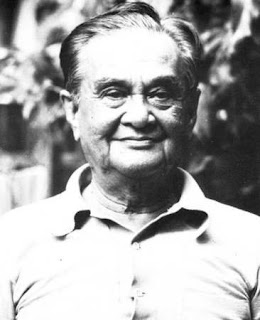SAINT RAJGURU CHOD (Thai เซนต์ครูชด) was modern Siam's pioneer yoga authority. His family name, Hasbamrer (หัศบำเรอ), is derived from Sanskrit Harshavarman and signifies Royal Khmer ancestry.
Saint Chod was born at the turn of the 20th century in the fifth Rattanakosin reign of King Chulalongkorn near the empire's southerly Andaman Sea. In youth, he attended Penang Free School and continued studies in Bombay India by Siamese overseas royal-sponsored scholarship. England awaited his arrival.
Upon graduation from Trinity College, Cambridge, Chod stayed in England taking up work as a journalist and advanced his career by returning to British India. But by 1937 he was back in Britain covering stories on the continent as well, semi-based in Berlin.
A few years later, due to looming war and personal health concerns, Chod set sail for India again. There he gained ascetic refuge with Swami Sivananda on the banks of the Ganges River near Rishikesh. It took him two years to cure his physical ailments. He stayed three years more to master yoga's higher forms.
After the war, Chod moved to Bangkok and established himself as a national news editor. He sometimes ran two papers at once while writing internationally for Reuters news agency. He also turned his home into a morning yoga center and drove to the newsroom after lunch.
At the strong and healthy age of seventy-five years, Guru Chod retired from journalism altogether and founded his celebrated yoga conservatoire. Though public demand was often unrelenting, he faced these challenges without complaint. "It's a good occupation for an old man," he said. "I like to be useful."
Patrons and disciples came from all walks of life. Yet most of them came from the kingdom's higher social strata. Furthermore, high-ranking members of the Buddhist clergy also sought the guru's guidance. Our tantric preceptor is particularly renowned for advising members of the Thai royal family. Although Rajguru Chod never spoke concerning such private matters himself, many around him openly did. It was simply common knowledge at that time.
Even well into his eighty-eighth year, Rajguru Chod continued to radiate charm and grace. He was typically surrounded by sparkling college girls, stunning flight attendants, breathtaking models, bankers' wives, industrialists, writers, opera singers and foreign diplomats. Road-tattered Western yoginis appeared, as well, aglow from extended travels East having heard along the way of a certain living legend. It is probably this that kees him teaching so long.
"But everyone has to die," Chod remarked, and he certainly gave us all fair warning. True to his prediction, on the eve of his eighty-eighth birthday he calmly stretched out on the floor and walked right out of there.
